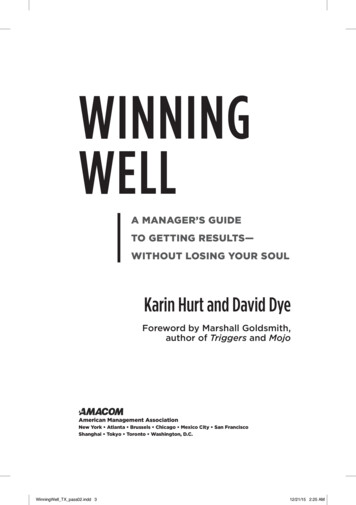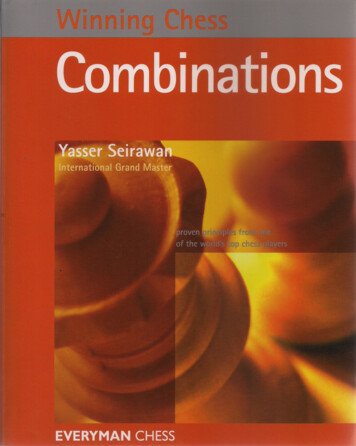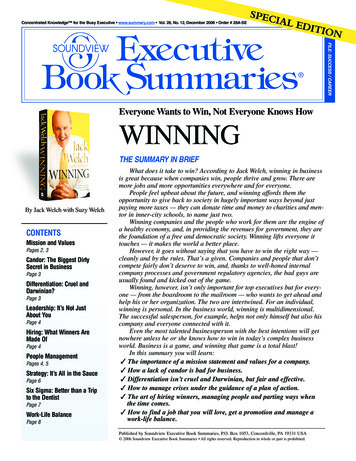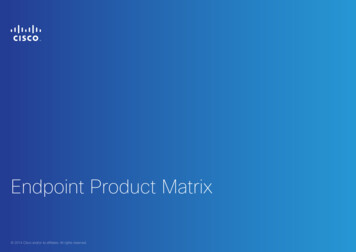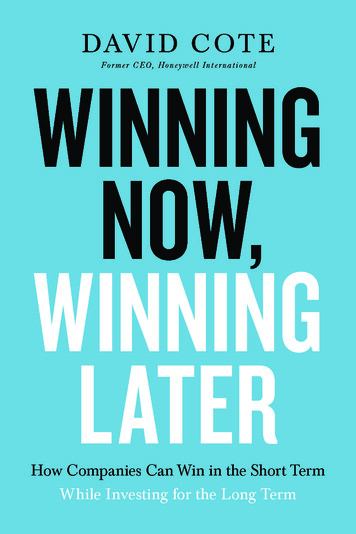
Transcription
TED-DONOTDUPLICATEWINNING WNOW,WINNING WLATERHHow Companies Can Succeed in the Short TermWhile Investing for the Long TermDAVID COTECOPYRIGHoTeWinningNowWinningLater 1P.indd 52/6/20 1:33 PM
CATEUPLIDTONO-D 2020 by David CoteTEDAll rights reserved. No portion of this book may be reproduced, stored in a retrievalsystem, or transmitted in any form or by any means— electronic, mechanical,photocopy, recording, scanning, or other— except for brief quotations in criticalreviews or articles, without the prior written permission of the publisher.HPublished by HarperCollins Leadership, an imprint of HarperCollins Focus LLC.PYRIGAny internet addresses, phone numbers, or company or product information printedin this book are offered as a resource and are not intended in any way to be or to implyan endorsement by HarperCollins Leadership, nor does HarperCollins Leadershipvouch for the existence, content, or services of these sites, phone numbers, companies,or products beyond the life of this book.COISBN 978-1-5995-1022-4 (eBook)ISBN 978-1-5995-1021-7 (HC)Library of Congress Cataloging- in- Publication DataCIP to come.Printed in the United States of America20 21 22 23 24 LSC 10 9 8 7 6 5 4 3 2 1WinningNowWinningLater 1P.indd 62/6/20 1:33 PM
CATEUPLIDTONO-DDTEHIGRPYOCWinningNowWinningLater 1P.indd 82/6/20 1:33 PM
CATEUPLIContentsDIntroductionONChapter 1: Banish Intellectual LazinessChapter 2: Plan for Today and TomorrowTPART I: LAY THE FOUNDATIONS-DOPART II: OPTIMIZE THE ORGANIZATIONPART III: INVEST TO GROWIGHTEDChapter 3: Resolve Serious Threats to the BusinessChapter 4: Focus on ProcessChapter 5: Build a High- Performance CultureChapter 6: Get and Keep the Right Leaders— but Not Too Many of ThemCOPYRChapter 7: Go Big on GrowthChapter 8: Upgrade Your PortfolioPART IV: PROTECT YOUR INVESTMENTSChapter 9: Take Control of the DownturnsChapter 10: Manage the Leadership TransitionEpilogueixWinningNowWinningLater 1P.indd 92/6/20 1:33 PM
CATEUPLIDTONO-DDTEHIGRPYOCWinningNowWinningLater 1P.indd 102/6/20 1:33 PM
CATEUPLIIntroductionICOPYRIGHTED-DONOTDf you run a team or an organization of any size, then there’s a seeminglyintractable dilemma you face each day: Should you focus on making thenumbers, often at the expense of the company’s future health, or shouldyou prioritize longer- term strategies, your quarterly or annual performance be damned?Most corporate managers and executives choose the first option,running businesses quarter- to- quarter to the detriment of long- termperformance. Leaders might value broader objectives like sustainability,competitiveness, and growth, and wax eloquent about their commitment to these long- term goals, but when called upon to allocate scarceresources, they focus on the current year’s plan and do what it takes tomeet their numbers. In their view, they have no choice: their job dependson pleasing bosses and shareholders today, not tomorrow.The notion that there is no way to pursue long- and short- term goalsat the same time, and therefore leaders have no choice but to embraceshort- termism, is one of the most pernicious beliefs circulating in business today. A McKinsey study found that firms that followed long- termstrategies amassed 7 billion more in market capitalization between 2001and 2014, and generated 47 percent more revenue growth and 36 percentmore earnings growth, on average, than companies that took a shorter- term approach.1 Nevertheless, as one 2014 study found, two- thirds ofexecutives and directors reported that “pressure for short- term resultshad increased over the previous five years.”2 Short- termism has becomexiWinningNowWinningLater 1P.indd 112/6/20 1:33 PM
IN T R O D U C T I O NTDUPLICATEso rampant that influential leaders are speaking out against it, with someadvocating that we relax the reporting requirements on public firms so thatleaders don’t feel such intense and constant pressure to make their numbers.We can’t regulate our way to long- termism— the problem is too complexand deeply entrenched. Instead, we need a comprehensive mind- set shift onthe part of leaders and managers at every level. Somehow we’ve convincedourselves that we can only invest in the future if we let short- term performance tank. But that’s not true. Strong short- and long- term performanceonly seem mutually exclusive. As a leader, you can and must pursue both atthe same time. Unless you do, you and your team or organization will neverreach your full potential.NOMY BATTLE WITH SHORT- T ERMISMCOPYRIGHTED-DOEarly in my career, when I worked in various finance and general management positions at General Electric, my colleagues and I were hell- bent onhitting our numbers in the current quarter and year. We’d think about nextyear, but only when we had to. This obsessive focus on today at the expenseof tomorrow didn’t make a lot of sense to me. Our business would performwell for most of a given year, and we’d hire a thousand people to help usgrow. Then in October and November, we’d create our plans for the coming year, only to realize we’d never make our numbers unless we laid off athousand people. So we’d do that, disrupting our business and the lives ofall those people. Why, I wondered, hadn’t we thought ahead and only hired,say, two hundred people instead of a thousand? And yet, like most leaders,we didn’t think we had a choice. We were working hard and doing the bestwe could, and we didn’t see another way.My opportunity to change as a leader began in February 2002, whenI became CEO of the industrial conglomerate Honeywell, a 22 billioncompany with interests in aerospace, control systems, automotive, andchemicals. The company was underperforming, having struggled in recentyears thanks to a botched merger with AlliedSignal in 1999, a couple of CEOxiiWinningNowWinningLater 1P.indd 122/6/20 1:33 PM
IN T R O D U C T I O NCOPYRIGHTED-DONOTDUPLICATEtransitions, and failed attempts to sell the company to United TechnologiesCorporation and then to General Electric. But from what recruiters, executives, and others had told me, and from what I could tell based on myown analysis, the company had some good businesses that had simply beenpoorly managed. Once someone stepped in, stabilized the organization,and got it focused on the future, Honeywell’s performance would bounceright back.During my first months on the job, as I began to probe into the company and its operations, I discovered the company didn’t really have goodfundamentals— it was all a façade. Honeywell was a train wreck and on theverge of failure. We had billions in unresolved environmental and asbestos liabilities, a woefully underfunded pension, an entrenched “make thequarter” mind- set, an organization beset by cultural warfare, depleted leadership ranks, no process initiatives in place to make us more efficient, noglobalization initiatives to help us grow in the rest of the world, significantunderinvestment in new products and services, and the list went on and on.But it got worse. Strangely, the board and the outgoing CEO refusedme any access to our financials until July 2002, when I became chairman.When I did gain access, I was hit almost immediately with a bombshell:our finance team informed me that we’d have to significantly reduce ourearnings commitment for the year. We wound up lowering our second- halfearnings projections twice by a cumulative 26 percent within a period ofweeks, infuriating analysts and investors who already lacked confidence inme. Investors knew I hadn’t been a finalist in the competition to succeed JackWelch as CEO at GE, and I hadn’t been the first choice to run Honeywell. Byreducing our earnings estimates so early in my tenure, and by having to doso not once but twice, I had just reinforced the investor community’s worstfears that I was a lightweight and didn’t have it in me to run a big companylike Honeywell.Meanwhile, my own worst fears about Honeywell materialized as Iprobed why we had missed our numbers. It turned out that our accountingwas at best unhealthy. No, we weren’t doing anything illegal— everythingdone fell within the parameters of permitted accounting practices— but thexiiiWinningNowWinningLater 1P.indd 132/6/20 1:33 PM
IN T R O D U C T I O NDUPLICATEentire organization was gaming the system to try to make their numberseach quarter (during the previous decade, for every dollar in earnings, weonly generated 69 cents in cash, a fact that reflected aggressive bookkeeping).As a result, our leaders lacked a clear and honest picture of their businesses.Accounting is your primary information system for making decisions, soif that information is bad, your decisions will be bad too. Our leaders weregoing through the motions, only pretending to run their businesses strategically or even competently. It was all a big mess— short- termism run horriblyamuck.OTPUTTING HONEY WELL ON A NEW PATHCOPYRIGHTED-DONI was flabbergasted, pissed, disgusted, and then some. But I wasn’t defeated.One day, in the heat of our financial mess, I turned on CNBC and heardthe commentators lambasting me, opining that I wasn’t equipped to runHoneywell. I listened to them, shrugged my shoulders, and returned to whatI had been doing. Someone in the room later told me how surprised theywere that I didn’t throw a hard object at the screen. But I wasn’t angry.Rather, I was thinking to myself, I’m going to show them. I’m going to figureout these problems and turn this company around.I was making a habit then of carving out time to sit by myself, put asidethe daily pressures of my job, and just think about the company. Duringone of these “blue book” sessions, as I called them (on account of the blue- covered notebook I used), I challenged myself to identify steps I would needto take to put Honeywell on a better path. As I sat there pondering, it cameto me that I would have to find a way to invest in new products, services,process improvement, geographical expansion, and so on. But given investors’ low opinion of me, I also had to deliver something for them in the shortterm— otherwise, I wouldn’t survive. I couldn’t push investment off to someunspecified future date, and I also couldn’t invest to such an extent that wefell short again of shareholder expectations. We would have to do both at thesame time— win today and set ourselves up to win tomorrow.xivWinningNowWinningLater 1P.indd 142/6/20 1:33 PM
IN T R O D U C T I O NUPLICATEFurther, I realized we could do both at the same time. Short- and long- term goals were more tightly intertwined than they appeared. By takingthe right actions to improve operations now, we could position ourselves toimprove performance later, while the reverse would also hold true: short- term results would validate that we were on the right long- term path. Beyondthat, I theorized we would be able to win today and tomorrow if we followedThree Principles of Short- and Long- Term Performance that I’d developed.Three Principles of Short- and Long- Term PerformanceOTD1. Scrub accounting and business practices down to what is real.2. Invest in the future, but not excessively.3. Grow while keeping fixed costs constantCOPYRIGHTED-DONFirst, we would address all of our unhealthy accounting and businesspractices, scrubbing the business down to what was real. Second, we wouldcourageously sacrifice some earnings today to invest in our future, but nottoo many— we would still take care to do well enough in the short term.Third, and relatedly, we would become far more disciplined about our operations, challenging ourselves to run our businesses more efficiently andeffectively so that we could keep our fixed costs constant as we grew. Doingso would provide us with the flexibility to deliver returns to investors whileinvesting in operational improvements and growth initiatives. As thoseimprovements and initiatives began to bear fruit, a virtuous cycle wouldtake hold: we’d improve our ability to perform, which would allow us togenerate even more cash to invest, which would lead to further performancegains, and so on.That was my basic approach, and it turned out to be correct. Over thenext several years, we did the seemingly impossible, stabilizing the company and progressing on a number of fronts simultaneously. We tightenedup our aggressive accounting, tackled environmental liabilities and otherlegacy issues, improved our processes and our culture, and invested in arange of growth initiatives, including customers, mergers and acquisitions(M&A), research and development (R&D), and globalization. In essence, byxvWinningNowWinningLater 1P.indd 152/6/20 1:33 PM
IN T R O D U C T I O NCOPYRIGHTED-DONOTDUPLICATEfollowing these three principles, we forced ourselves to consider the long- and short- term implications in every decision we made, instilling culturaland operational norms that allowed our company to deliver more value atall times. We turned our company into a performance machine, one thatsatisfied shareholders’ quarterly cravings while also becoming much nimbler, more efficient, more innovative, and more customer- centric over thelong term.By 2008, when the Great Recession hit, we were already on firmerground, but because we continued to implement a dual short- and long- termapproach, we made a number of unorthodox moves that positioned us toexpand rapidly once the recession ended. And expand we did. By 2018, whenI left the company, our market capitalization had soared from 20 billion to 120 billion, Honeywell had generated returns of about 800 percent (beating the S&P 500 by about two and a half times), and the company had wonhigh- profile awards for financial and environmental stewardship. We hadalso created 2,500 401(k) millionaires because employees had invested inHoneywell, with 95 percent of them below the executive level and the lowestcompensated earning an annual salary of only 43,000.If our experience proves anything, it’s that you don’t have to be a geniusto achieve remarkable short- and long- term performance (we certainly weren’t). You also don’t have to have some magic formula— we didn’t, beyondthe Three Principles of Short- and Long- Term Performance. What you dohave to do is believe you can achieve two seemingly conflicting things atthe same time— short- term performance and investment in the future. Andthen, on a daily, operational level, you have to dedicate yourself to actuallydoing it, pushing yourself and others on your team and organization to gobeyond what they think is possible, every small step of the way. Leadershipmatters— it really does. And the trick, as I like to say, is in the doing. Mostleaders know what needs to happen operationally and strategically. Theyknow they must do a good job for customers, come out with new productsand services, pursue globalization, motivate their workforce, and so on. Butmost businesses don’t execute all that well. To perform well today whileinvesting in tomorrow, your business has to do what everyone else claimsxviWinningNowWinningLater 1P.indd 162/6/20 1:33 PM
IN T R O D U C T I O NCATEto be doing. And that will only happen if you as the leader demand it at theoutset and accept no compromises.ABOUT THIS BOOKCOPYRIGHTED-DONOTDUPLIThe chapters that follow show you how to turn your business or organization into a performance machine, in any season. I lay out ten key strategicand operational strategies we deployed in line with these Three Principlesof Short- and Long- Term Performance. In part I, “Lay the Foundations,” Iexplore the intellectual basis required for achieving strong long- and short- term results at the same time. As we’ll see in chapter 1, you must first learnhow to think about your business in a far more rigorous and demandingway, and how to help others around you do the same. That means challenging yourself and others to go beyond binary oppositions and do twoconflicting things at the same time. In chapter 2, I’ll argue that you mustalso translate that mind- set of intellectual discipline and curiosity into yourstrategic planning, committing yourself to honesty and transparency andto having real conversations about your business or organization, its challenges, and its future.Part II of this book, “Optimize the Organization,” discusses investments you must make to free yourself of challenges that might be draggingdown your performance. In chapter 3, I detail how we swallowed hard andaddressed Honeywell’s longstanding pension, environmental, and asbestos liability issues. In chapters 4, 5, and 6, I describe how we invested inimproving our inefficient and ineffective processes, ending the culture warsthat were hobbling us, and rebuilding and enhancing our depleted corps ofleaders. Each of these efforts, funded by keeping fixed costs steady whilegrowing our company, dramatically improved our ability to perform overboth the short and long term.Part III, “Invest to Grow,” deals with investment decisions you can makenow to ensure your future expansion. In chapters 7 and 8, I explain howwe invested in areas like customer experience, research and development,xviiWinningNowWinningLater 1P.indd 172/6/20 1:33 PM
IN T R O D U C T I O NCOPYRIGHTED-DONOTDUPLICATEglobalization, and mergers and acquisitions, getting the most value for ourinvestment without compromising short- term performance unduly. Part IV,“Protect Your Investments,” explores how to sustain a short- and long- termapproach in challenging times. Chapter 9 reveals how we used this approachduring the Great Recession to help us achieve explosive performance afterward, while chapter 10 examines how to think differently about leadershiptransitions, ensuring that superior long- and short- term performance cancontinue even after you’re gone. I close the book with an epilogue that callson all of us to challenge ourselves and others to go beyond what seemspossible so that we can achieve our fullest potential as leaders and help ourteams and organizations out- perform.As you read this book, I invite you to expand your horizons and breakfree of diminished expectations. Don’t assume you have to forego long- term investment to survive quarter- to- quarter, and don’t fall back on thatas an excuse for failing to invest. Organizations of all sizes and all kinds— businesses and nonprofits— have it in them to perform much better than theycurrently do, over all time horizons. Leaders just have to believe this— andthen start executing. Non- profits in particular seem to have a high tolerancefor poor performance at the individual and organizational levels. If we atHoneywell could invest in the future while delivering short- term results ata failing company, think of what your team or organization could do.Overcoming short- termism isn’t just an imperative for individual businesses but for the broader economy. Capitalism has been the greatest forcefor good the world has ever seen, raising billions of people out of poverty asgovernments enabled individual businesses to thrive, as businesses droveproductivity gains, and as standards of living (which are linked to productivity) rose. But there’s no guarantee that economies will continue to thrivein the years ahead, or that American businesses will flourish. As Chinacontinues its rise to power, competition in global markets will intensify,and US firms will have to sustain new levels of productivity and innovation to remain on top, just as they did during the 1980s when they were incompetition with Japanese companies. Yet shareholders will only fund thesignificant investments companies must make in research and development,xviiiWinningNowWinningLater 1P.indd 182/6/20 1:33 PM
IN T R O D U C T I O NCOPYRIGHTED-DONOTDUPLICATEprocess improvement, and culture if they see adequate, short- term returnson their investments.It’s thus incumbent on leaders to pursue growth and deliver quarterlyresults. Offering Honeywell as a case study, Winning Now, Winning Latershows how you can run organizations with a new kind of balance, discipline,rigor, and energy, investing in growth while performing well now. We canwin against Chinese companies and turn our competition with those firmsinto a source of opportunity. We can take our own companies to new levels ofperformance. But only if we’re ready to demand more of our organizations— and of ourselves. So what are you waiting for? Go ahead and take a chance.You can do it. Let’s get started!xixWinningNowWinningLater 1P.indd 192/6/20 1:33 PM
CATEUPLIDTONO-DDTEHIGRPYOCWinningNowWinningLater 1P.indd 202/6/20 1:33 PM
CATEUPLIPART ONECOPYRIGHTED-DONOTDLAY THE FOUNDATIONWinningNowWinningLater 1P.indd 12/6/20 1:33 PM
CATEUPLIDTONO-DDTEHIGRPYOCWinningNowWinningLater 1P.indd 22/6/20 1:33 PM
CATECHAPTER ONEDUPLIBanish Intellectual LazinessICOPYRIGHTED-DONOTn 2003, about a year after becoming Honeywell’s CEO, I traveled to theheadquarters of our Aerospace division in Phoenix, Arizona, to conducta review of the business. I was working hard at the time on implementingwide- ranging cultural change across Honeywell, and the Aerospace division seemed reluctant to buy in. No surprise: the executive leading it— I’llcall him Rich— had interviewed unsuccessfully for my job, and likely harbored some resentment. In making the trip, I hoped to strengthen myrelationship with Rich and his team, familiarize them with my desire tofocus Honeywell on both short- and long- term goals, and offer up ideasfor improving the division’s performance.My visit began smoothly enough. Shaking hands with members ofRich’s team, I found them polite and seemingly happy to see me. We satdown in a conference room so that team members could present theirstrategic plan to me. A copy of the plan had been placed on the tablefacing each seat. Flipping through mine, I saw that it was thick— maybe150 pages long, full of charts and tables. Uh- oh, I thought, not good. I hadfound so far at Honeywell that executives and managers often made presentations far longer than necessary, overwhelming audience memberswith facts, figures, and commentary in an effort to preempt sharp, criticalquestioning. “Looks like you guys have done a lot of thinking here,” I said,pointing to the thickness of the binder. “I can’t wait to hear it.”3WinningNowWinningLater 1P.indd 32/6/20 1:33 PM
W IN NIN G N O W, W IN N IN G L AT E RCOPYRIGHTED-DONOTDUPLICATERich nodded at a member of his team, who began running through thepresentation. It started with a review of the market. So far, so good. But afew minutes later, when we were on page five, I stopped to inquire about thestatus of Primus Epic, a terrific new cockpit avionics system we were developing. The team assured me the project was proceeding on schedule andon budget. Then, a page or two later, I posed another question about maintaining our lead in another product line of ours, auxiliary power units, theengines that provide power to an aircraft when it is on the ground. AlthoughRich’s team members answered my question and smiled politely at me, theyseemed unhappy, exchanging glances with one another that seemed to say,“Can you believe this guy?” They continued with the presentation, but aboutfive minutes later, when they were on page fourteen, I stopped them yetagain, inquiring about overruns that had exceeded 800 million on our biggest programs.Rich had had enough. “You know, Dave,” he said, “if you don’t mind,I’d really like the team to continue. We’ll get to that point soon enough.”I glanced over at him. “I’d like to know about it now.”“Really, we cover it later. I can assure you, all of your questions will beanswered.”“Okay,” I said, “I believe you. What page is it on?”He glanced at one of his team members, who flipped through his copyof the presentation. “Top of page thirty- six,” this executive said.I went to the top of page thirty- six and scanned the chart there. “Nope,that covers just Primus Epic overruns. I want to understand the root cause ofour overrun problems. Is it bad estimating? Bad executing? Something else?I want to get us to the point where we can anticipate the real cost so that wecan plan for it and execute.”Rich shot me a hard look. “Dave, before we go any further, I have toobject to how you’re running this meeting. We put a lot of time and effortinto crafting this pitch for you. Please show us the courtesy of listening toit all the way through.”“I understand, Rich,” I said, “but let’s discuss the purpose of this presentation. If we’re here for the team to put on a show for me, then you’re4WinningNowWinningLater 1P.indd 42/6/20 1:33 PM
B anish Intellectual L azinessCOPYRIGHTED-DONOTDUPLICATEright, I should sit back and listen. But if the point is for me to learn aboutyour business and its issues, then we need to conduct the presentation in away that facilitates my learning. I need to ask questions right away, get theanswers I need, and then move on. Can we do that?”Rich relented, and I was able to review their business in a rigorous andproductive way that ultimately uncovered opportunities for better short- andlong- term management. What I learned, to my chagrin, was that Aerospacehad become adept at lying to itself, shoehorning costs here and there into abudget without acknowledging them openly. This put enormous strain onthe organization, which then had to patch together significant short- termfixes throughout the year, including more aggressive bookkeeping and special deals with customers and others, to make its goals. A dysfunctionalapproach if I’d ever seen one.Fundamentally, managing for both the short and long term isn’t aboutchanging specific processes, policies, or strategies, but rather about adoptinga different, more intellectual mind- set. Planting seeds for the future whilealso achieving short- term results is much harder to pull off than just aimingfor one of these goals exclusively. It’s so hard, in fact, that many executivesand managers throw up their hands. Absolving themselves of any responsibility to achieve both short- and long- term goals, they shrink from askingtough questions and actively shield themselves and others from probing toodeeply. Instead of finding new ways to support innovation and investmentwhile achieving short- term goals, they content themselves with the same oldstrategies, policies, and procedures, relying on accounting sleight- of- handto make it all work.Don’t let this be you. You can achieve short- and long- term goals simultaneously, but that means you will need to puzzle it out, quarter after quarter,year after year. Challenge yourself, your team, and your organization tothink harder about customers, markets, and processes than you previouslyhave. Cultivate a mind- set of analytic rigor and attention to detail. Askchallenging questions of yourself and others, and push hard until you’veuncovered satisfying answers, even if that means acknowledging difficult5WinningNowWinningLater 1P.indd 52/6/20 1:33 PM
W IN NIN G N O W, W IN N IN G L AT E RACCOMPLISHING TWO SEEMINGLY CONFLICTINGTHINGS AT THE SAME TIMECATEtruths. Decide right now to become a serious, engaged, and honest scholarof your business instead of a passive overseer of it.COPYRIGHTED-DONOTDUPLIMy own heightened appreciation for intellectual rigor dates from the early1990s, when I served as CFO at General Electric’s major appliance business.We were trying to reduce the amount of capital we deployed in operatingour businesses, and in line with that goal, my boss had decided that ourbusiness unit needed to reduce the 1 billion in inventory we maintained.Guess whose job it was to lead the inventory reduction effort? The assignment caught me by surprise— I wasn’t sure how to proceed. I had seen otherbusinesses flounder when pursuing such initiatives. The boss would decreethat henceforth the company would only keep a certain amount of inventoryon hand to shrink the amount of cash it had locked up. Months later, inventory levels would creep back up, and the amount of cash locked up wouldincrease as well— again.I wanted to try a new approach, but I didn’t know what that would be.We convened a cross- functional team and asked them: Why did inventoryreduction initiatives usually fail? What can we do differently? “If we’re goingto fail,” I said, “let’s at least do it differently. The definition of insanity isdoing the same thing over and over, always expecting a different result.” Amanufacturing leader identified dissatisfied customers as the reason whythese initiatives usually failed. Once a business reduced inventory, customerdelivery usually suffered because we didn’t have the items we needed instock. Customers complained, and the sales force applied pressure on thebusiness to stock more product. Eventually inventory levels were right backwhere they had been. Inventory levels and customer satisfaction were directlyrelated. You could have lower inventory levels, or high customer satisfaction,but not both. You had to choose between two seemingly conflicting things.That, at least, was the conventional wisdom. We wondered if we could6WinningNowWinningLater 1P.indd 62/6/20 1:33 PM
B anish Intellectual L azinessCOPYRIGHTED-DONOTDUPLICATEfind a way to reduce inventory levels while also keeping our products readilyavailable and ready to ship so that customer satisfaction wouldn’t plummet. My team and I spent an entire day puzzling over it. At some point ateam member urged us to take a step back and assess our entire process,from forecasting, to supply chain, to manufacturing, to transportation, todistribution. Running an analysis, we found that it took eighteen weeksend- to- end, from when a product was shipped out of the warehouse to thepoint when manufacturing was told to replace it and then it was produced,shipped, and replaced in the warehouse. That seemed like an extraordinarilylong time. What if we could render the whole process more efficient, shrinking our “cycle time,” as we called it, down to a couple of days? We’d be ableto reduce warehouse inventory while still
Investors knew I hadn’t been a finalist in the competition to succeed Jack Welch as CEO at GE, and I hadn’t been the first choice to run Honeywell. By reducing our earnings estimates so early in my tenure, and by having to do . WINNING



